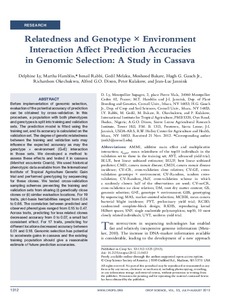| dc.contributor.author | Ly, D. |
| dc.contributor.author | Hamblin, M. |
| dc.contributor.author | Rabbi, Ismail Y |
| dc.contributor.author | Gedil, M. |
| dc.contributor.author | Bakare, M.A. |
| dc.contributor.author | Gauch Jr. H. |
| dc.contributor.author | Okechukwu, R.U. |
| dc.contributor.author | Dixon, A. |
| dc.contributor.author | Kulakow, P.A. |
| dc.contributor.author | Jannink, Jean-Luc |
| dc.date.accessioned | 2019-12-04T11:03:53Z |
| dc.date.available | 2019-12-04T11:03:53Z |
| dc.date.issued | 2013-07 |
| dc.identifier.citation | Ly, D., Hamblin, M., Rabbi, I. Y., Gedil, M., Bakare, M. A., Gauch Jr. H., ... & Jannink, J. (2013). Relatedness and genotype× environment interaction affect prediction accuracies in genomic selection: a study in cassava. Crop Science, 53(4), 1312-1325. |
| dc.identifier.issn | 0011-183X |
| dc.identifier.uri | https://hdl.handle.net/20.500.12478/1270 |
| dc.description | . |
| dc.description.abstract | Before implementation of genomic selection, evaluation of the potential accuracy of prediction can be obtained by cross-validation. In this procedure, a population with both phenotypes and genotypes is split into training and validation sets. The prediction model is fitted using the training set, and its accuracy is calculated on the validation set. The degree of genetic relatedness between the training and validation sets may influence the expected accuracy as may the
genotype × environment (G×E) interaction in those sets. We developed a method to assess these effects and tested it in cassava (Manihot esculenta Crantz). We used historical phenotypic data available from the International Institute of Tropical Agriculture Genetic Gain trial and performed genotyping by sequencing
for these clones. We tested cross-validation sampling schemes preventing the training and validation sets from sharing (i) genetically close clones or (ii) similar evaluation locations. For 19 traits, plot-basis heritabilities ranged from 0.04 to 0.66. The correlation between predicted and observed phenotypes ranged from 0.15 to 0.47. Across traits, predicting for less related clones decreased accuracy from 0 to 0.07, a small but consistent effect. For 17 traits, predicting for different locations decreased accuracy between 0.01 and 0.18. Genomic selection has potential to accelerate gains in cassava and the existing training population should give a reasonable estimate of future prediction accuracies. |
| dc.format.extent | 1312–1325 |
| dc.language.iso | en |
| dc.subject | Phenotypes |
| dc.subject | Genotypes |
| dc.subject | Cassava |
| dc.title | Relatedness and genotype x environment interaction affect prediction accuracies in genomic selection: a study in cassava |
| dc.type | Journal Article |
| dc.description.version | Peer Review |
| cg.contributor.crp | Roots, Tubers and Bananas |
| cg.contributor.affiliation | Montpellier SupAgro |
| cg.contributor.affiliation | Cornell University |
| cg.contributor.affiliation | International Institute of Tropical Agriculture |
| cg.contributor.affiliation | Sierra Leone Agricultural Research Institute |
| cg.contributor.affiliation | United States Department of Agriculture |
| cg.coverage.region | Africa |
| cg.coverage.region | West Africa |
| cg.coverage.country | Nigeria |
| cg.isijournal | ISI Journal |
| cg.authorship.types | CGIAR and developing country institute |
| cg.iitasubject | Cassava |
| cg.journal | Crop Science |
| cg.howpublished | Formally Published |
| cg.accessibilitystatus | Open Access |
| local.dspaceid | 78673 |
| cg.identifier.doi | https://dx.doi.org/10.2135/cropsci2012.11.0653 |

